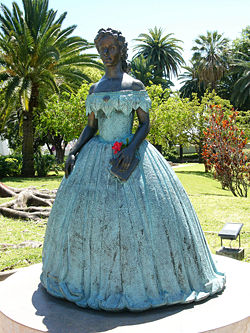Elisabeth of Bavaria
| Elisabeth of Bavaria | |
|---|---|
| Empress consort of Austria; Queen consort of Hungary, Croatia, and Bohemia (more...) | |
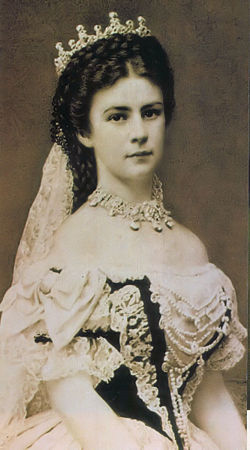 |
|
| Consort | 24 April 1854 - 10 September 1898 |
| Consort to | Franz Joseph I |
| Issue | |
| Archduchess Sophie of Austria Archduchess Gisela of Austria Rudolf, Crown Prince of Austria Archduchess Marie-Valerie of Austria |
|
| Titles and styles | |
| HI&RM The Empress of Austria HRH Duchess Elisabeth in Bavaria |
|
| Royal house | House of Habsburg-Lorraine House of Wittelsbach |
| Father | Duke Maximilian Joseph in Bavaria |
| Mother | Princess Ludovika of Bavaria |
| Born | December 24, 1837 |
| Died | September 10, 1898 (aged 60) |
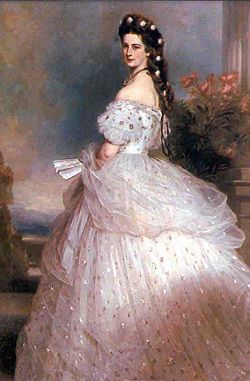
Elisabeth Amalie Eugenie (24 December 1837 – 10 September 1898) of the House of Wittelsbach, was the Empress consort of Austria and Queen consort of Hungary, being married to the Emperor Franz Joseph I. Her father was Maximilian Joseph, Duke in Bavaria and her mother was Ludovika, Royal Princess of Bavaria; her family home was Possenhofen Castle. From an early age, she was called “Sissi” by family and friends.
Contents |
Life
She was born in Munich, Bavaria. Elisabeth accompanied her mother and her 18-year-old sister, Helene, on a trip to the resort of Bad Ischl, Upper Austria [1], where they hoped Helene would attract the attention of their maternal first cousin, 23-year-old Franz Joseph, then Emperor of Austria. Instead, Franz Joseph chose Elisabeth, and the couple were married in Vienna at St. Augustine's Church on 24 April, 1854. Elisabeth later wrote that she regretted accepting his proposal for the rest of her life.
Elisabeth had difficulty adapting to the strict etiquette practiced at the Habsburg court. Nevertheless, she bore the emperor three children in quick succession: Archduchess Sophie of Austria (1855–1857), Archduchess Gisela of Austria (1856–1932), and the hoped-for crown prince, Rudolf (1858–1889). In 1860, she left Vienna after contracting a lung-disease which was presumably psychosomatic. She spent the winter in Madeira and only returned to Vienna after having visited the Ionian Islands. Soon after that she fell ill again and returned to Corfu. After that Elisabeth began to use her beauty to gain influence on her husband. She achieved her only political goal whereby in 1867 she and Franz Joseph were crowned King and Queen of Hungary, and ten months later, another child Archduchess Marie Valerie of Austria (1868–1924) followed. Elisabeth was denied any major influence on her older children's upbringing, however — they were raised by her mother-in-law Sophie, who often referred to Elizabeth as their "silly young mother.[1]" Soon after Marie Valerie's birth the marriage again started to deteriorate, undone by Elisabeth's increasingly erratic behaviour.
To ease her pain and illnesses, Elisabeth embarked on a life of travel, seeing very little of her offspring, visiting places such as Madeira, Hungary, England, and Corfu, where she commissioned the building of a castle which she called Achilleion — after her death the building was sold to the German Emperor Wilhelm II. She not only became known for her beauty, but also for her fashion sense, diet and exercise regimens, passion for riding sports, and a series of reputed lovers. She paid extreme attention to her appearance and would spend most of her time preserving her beauty. Her diet and exercise regimens were strictly enforced to maintain her 20-inch (50 cm) waistline and reduced her to near emaciation at times (symptoms of what is now recognised as anorexia). One of the few things she would eat was raw veal meat juice, squeezed from her juice press, then boiled and seasoned. One of her alleged lovers was George "Bay" Middleton, a dashing Anglo–Scot who was probably the father of Clementine Ogilvy Hozier (the wife of Winston Churchill). She also tolerated, to a certain degree, Franz Joseph's affair with actress Katharina Schratt.
National unrest within the Habsburg monarchy caused by the rebellious Hungarians led, in 1867, to the foundation of the Austro–Hungarian double monarchy, making Elisabeth Empress of Austria and Queen of Hungary. Elisabeth had always sympathized with the Hungarian cause and, reconciled and reunited with her alienated husband, she joined Franz Joseph in Budapest, where their coronation took place. In due course, their fourth child, Archduchess Marie Valerie was born (1868–1924). Afterwards, however, she again took up her former life of restlessly travelling through Europe.
The Empress also engaged in writing poetry (such as the "Nordseelieder" and "Winterlieder", both inspirations from her favorite German poet, Heinrich Heine). Shaping her own fantasy world in poetry, she referred to herself as Titania, Shakespeare's Fairy Queen. Most of her poetry refers to her journeys, classical Greek and romantic themes, as well as ironic mockery on the Habsburg dynasty. In these years, Elisabeth also took up with an intensive study of both ancient and modern Greek, drowning in Homer's Iliad and Odyssey. Numerous Greek lecturers (such as Marinaky, Christomanos, and Barker) had to accompany the Empress on her hour-long walks while reading Greek to her. According to contemporary scholars, Empress Elisabeth knew Greek better than any of the Bavarian Greek Queens in the 19th century.
In 1889, Elisabeth's life was shattered by the death of her only son: 30-year-old Crown Prince Rudolf and his young lover Baroness Mary Vetsera were found dead, apparently by suicide. The scandal is known by the name Mayerling, after the name of Rudolf's hunting lodge in Lower Austria.
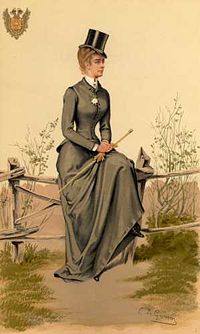
After Rudolf's death, the Empress continued to be an icon, a sensation wherever she went: a long black gown that could be buttoned up at the bottom, a white parasol made of leather and a brown fan to hide her face from curious looks became the trademarks of the legendary Empress of Austria. Only a few snapshots of Elisabeth in her last years are left, taken by photographers who were lucky enough to catch her without her noticing. The moments Elisabeth would show up in Vienna and see her husband were rare. Interestingly, their correspondence increased during those last years and the relationship between the Empress and the Emperor of Austria had become platonic and warm. On her imperial steamer, Miramar, Empress Elisabeth travelled restlessly through the Mediterranean. Her favourite places were Cap Martin on the French Riviera, where tourism had only started in the second half of the 19th century, Lake Geneva in Switzerland, Bad Ischl in Austria, where she would spend her summers, and Corfu. More than that, the Empress had visited countries no other Northern royal went to at the time: Portugal, Spain, Morocco, Algeria, Malta, Greece, Turkey and Egypt. Travel had become the sense of her life but also an escape from herself.
Assassination
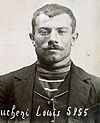
On 10 September 1898, in Geneva, Switzerland, Elisabeth, aged 60, was stabbed in the heart with a sharpened file by a young anarchist named Luigi Lucheni, in an act of propaganda of the deed. She had been walking along the promenade of Lake Geneva about to board steamship Genève for Montreux with her lady-of-courtesy, Countess Sztaray, when she was attacked. Unaware of the severity of her condition she still boarded the ship. Bleeding to death from a puncture wound to the heart, Elisabeth's last words were "What happened to me?"[2] The strong pressure from her corset kept the bleeding back until the corset was removed. Only then did her staff and surrounding onlookers understand the severity of the situation. Reportedly, her assassin had hoped to kill a prince from the House of Orléans and, failing to find him, turned on Elisabeth instead. As Lucheni afterward said, "I wanted to kill a royal. It did not matter which one."[3]
The empress was buried in the Imperial Crypt in Vienna's city centre which has for centuries served as the Imperial burial place.
The myth
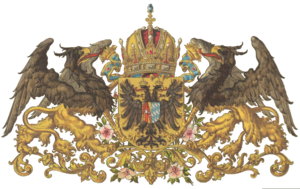
While Elisabeth's role and influence on Austro-Hungarian politics should not be overestimated (she is only marginally mentioned in scholarly books on Austrian history), she has undoubtedly become a 20th century icon, often compared to Diana, Princess of Wales. She was considered to be a free spirit who abhorred conventional court protocol. She has inspired filmmakers and theatrical producers alike.
In the 1980s, Brigitte Hamann, a historian renowned for her book on Hitler's early years in Vienna (see bibliography), wrote a biography of Elisabeth, again fuelling interest in Franz Joseph's consort.
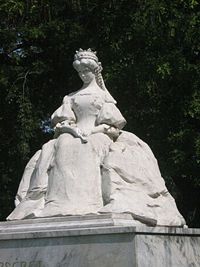
Tourism has profited enormously from the renewed interest in Elisabeth and vice versa, both in Austria and abroad. Apart from the usual souvenirs such as T-shirts and coffee mugs, visitors are eager to see the various residences Elisabeth frequented at different points in her life. These include her apartments in the Hofburg and the Schönbrunn Palace in Vienna, the imperial villa in Ischl, the Achilleion in Corfu, Greece that she built in 1890, soon after her son's tragic death, and her summer residence in Gödöllő, Hungary.
Elisabeth loved Hungary far more than Austria and surrounded herself with Hungarian ladies-in-waiting, being particularly close to Marie Festetics and Ida Ferenczy. She insisted that her attendants speak Hungarian, which she herself spoke fluently. One of her closest friends was Count Andrássy, who later became Emperor Franz-Joseph's Foreign Minister. Elisabeth's attachment to Hungary benefitted the Empire because the Hungarian people returned the attachment but also antagonized the Viennese and the Czechs of Bohemia. There are several sites in Hungary named after her, two of Budapest's districts, Erzsébetváros and Pesterzsébet, and most famously, Elisabeth Bridge.
- Empress Elisabeth and the Austrian Western Railway named after her was recently selected as a main motif for a high value collectors' coin: the Empress Elisabeth Western Railway commemorative coin. The reverse shows a view of the passenger hall of the first Vienna West Railway Station. The style of this building was inspired by Romantic Historism. On the right of the coin, the statue of the Empress Elisabeth can be seen. This statue still stands today in the station.
In literature, film, television and theatre
In the German-speaking world, her name will forever be associated with a trilogy of romantic films about her life directed by Ernst Marischka and starring a teenaged Romy Schneider in the title role:
- Sissi (1955)
- Sissi — die junge Kaiserin (1956) (Sissi — The Young Empress)
- Sissi — Schicksalsjahre einer Kaiserin (1957) (Sissi — Fateful Years of an Empress)
The three films, now newly restored, are shown every Christmas on Austrian and German TV and have done much to create the myth surrounding Elisabeth. A condensed version dubbed in English was published under the title Forever My Love.
Schneider loathed the role, claiming, "Sissi sticks to me like porridge (Griessbrei)." Later she was able to achieve a sort of satisfaction, appearing as a much more realistic and fascinating Elisabeth in Luchino Visconti's Ludwig a 1972 movie about Elisabeth's cousin, Ludwig II of Bavaria. A portrait of herself in this film was the only one of her roles she had displayed in her home.
Ava Gardner also played the Empress in the 1968 film Mayerling. (Omar Sharif and Catherine Deneuve played the doomed lovers). She, also, had one sole film portrait of herself on display in her home: it was from this film.
She was the subject of a 1991 German movie called Sissi/Last Minute (original Sisi und der Kaiserkuß "Sissi and the kiss of the Emperor"). The movie starred Vanessa Wagner as Sissi, Nils Tavernier as Emperor Franz Joseph and Sonja Kirchberger as Nene.[4]
In 1974, Elisabeth was portrayed in the British television series Fall of Eagles by Diane Keen (as the young Elisabeth) and Rachel Gurney (as Elisabeth at the time of Prince Rudolf's death).
In Japan, the Takarazuka Revue Company has performed a large musical version of her life since 1996. (See the "In Music" section).
Her story also became part of a series: The Royal Diaries: Elisabeth: The Princess Bride. In one of the episodes of the Austrian TV show, Kommissar Rex (1994), about a police dog who always solves his police-inspector owner's cases, the myth of Sissi is shown under the influence of her story on a young woman who often sneaks into a palace where Sissi lived and starts acting like her during the night, when the museum is closed. This includes riding in the park, using hair ornaments similar to the ones Elisabeth was known for using and even sleeping in the Empress's bed, dressed in vintage nightwear, after having brushed her hair in Sissi's way, separating it in two parts spread over the pillow so that the strands wouldn't be mussed by morning: all this, of course, using Sissi's old brush. This episode, the thirteenth of Season 5 of the show (and the last from that season), is called "Sissi" and originally aired on 22 April 1999. The empress-obsessed character's name is Marion, and she is played by actress Marion Mitterhammer.
Her younger years are portrayed in a children's series in 1997 called Princess Sissi.
In 2007, German comedian and director Michael Herbig released a computer-animated parody film of Sissi's character under the title Lissi und der wilde Kaiser (lit.: "Lissi and the Wild Emperor"). It is based on his Sissi parody sketches featured in his TV show Bullyparade.
In dance and music
Fritz Kreisler composed a comic opera 'Sissi', which premiered in Vienna in 1932. The libretto was written by Ernst and Hubert Marischka, with orchestrations by Robert Russell Bennett.[5]
In 1992, the musical Elisabeth premièred at the Theater an der Wien in Vienna, Austria. Written by Michael Kunze (libretto, lyrics) and Sylvester Levay (music), with the leading role of the Empress played by Pia Douwes of the Netherlands. It has also been produced successfully in Hungary, Germany, Switzerland, the Netherlands, Sweden, Finland and in Japan, with Douwes also again performing the role of Sissi in the Netherlands, Berlin, Essen and Stuttgart.
In the film version of Andrew Lloyd Webber's The Phantom of the Opera, the character Christine is wearing a gown inspired by a portrait of Elizabeth of Bavaria by Franz Xavier Winterhalter during her opera debut when she performs the song "Think of Me".
French ballet dancer Sylvie Guillem appeared to great acclaim at the Paris Opera Ballet in a piece titled Sissi Imperatice , choreographed by Maurice Bejart.
Elisabeth has a featured role in Kenneth MacMillan's ballet, Mayerling including a pas de deux with her son Prince Rudolf, the central character in the ballet; and a notable pas de six with five male partners, Bay Middleton and four Hungarian officers, friends of her son.
Dutch singer Petra Berger's album Eternal Woman includes "If I Had a Wish", a song about Elisabeth.
Issue
| Name | Birth | Death | Notes |
|---|---|---|---|
| Sophie Friederike Dorothea Maria Josepha | 5 March 1855 | 29 May 1857 | Died in childhood. |
| Gisela Louise Marie | 15 July 1856 | 27 July 1932 | Married, 1873 her second cousin, Prince Leopold of Bavaria; had issue. |
| Rudolf Francis Charles Joseph | 21 August 1858 | 30 January 1889 | died in the Mayerling Incident Married, 1881, Princess Stephanie of Belgium; had issue. |
| Marie Valerie Mathilde Amalie | 22 April 1868 | 6 September 1924 | Married, 1890 her secound cousin, Archduke Franz Salvator of Austria-Tuscany; had issue. |
Ancestry
| Ancestors of Elisabeth of Bavaria | ||||||||||||||||||||||||||||||||||||||||||||||||||||||||||||||||||||||||||||||||||||||||||||||||||||||||||||||||||||||||||||||||||||||||||||||||||||||||||||||||||||||||||||||||||||||||||||||||||||||||||||||||||||||||||||||||||||||||||||||||||||||||||||||||||||||||||||||||||||||||||||||||||||||||||||||||||||||||||||||||||||||||||||||||||||||||||||||||||||||||||||||||||||||||||||||||||||||||||||||||||||||||||||||||||||||||||||||||||||||||||||||||||||||||||||||||||||||||||||||||||||||||||||||||||||||||||||||||||||||||||||||||||||||||||||||||||
|---|---|---|---|---|---|---|---|---|---|---|---|---|---|---|---|---|---|---|---|---|---|---|---|---|---|---|---|---|---|---|---|---|---|---|---|---|---|---|---|---|---|---|---|---|---|---|---|---|---|---|---|---|---|---|---|---|---|---|---|---|---|---|---|---|---|---|---|---|---|---|---|---|---|---|---|---|---|---|---|---|---|---|---|---|---|---|---|---|---|---|---|---|---|---|---|---|---|---|---|---|---|---|---|---|---|---|---|---|---|---|---|---|---|---|---|---|---|---|---|---|---|---|---|---|---|---|---|---|---|---|---|---|---|---|---|---|---|---|---|---|---|---|---|---|---|---|---|---|---|---|---|---|---|---|---|---|---|---|---|---|---|---|---|---|---|---|---|---|---|---|---|---|---|---|---|---|---|---|---|---|---|---|---|---|---|---|---|---|---|---|---|---|---|---|---|---|---|---|---|---|---|---|---|---|---|---|---|---|---|---|---|---|---|---|---|---|---|---|---|---|---|---|---|---|---|---|---|---|---|---|---|---|---|---|---|---|---|---|---|---|---|---|---|---|---|---|---|---|---|---|---|---|---|---|---|---|---|---|---|---|---|---|---|---|---|---|---|---|---|---|---|---|---|---|---|---|---|---|---|---|---|---|---|---|---|---|---|---|---|---|---|---|---|---|---|---|---|---|---|---|---|---|---|---|---|---|---|---|---|---|---|---|---|---|---|---|---|---|---|---|---|---|---|---|---|---|---|---|---|---|---|---|---|---|---|---|---|---|---|---|---|---|---|---|---|---|---|---|---|---|---|---|---|---|---|---|---|---|---|---|---|---|---|---|---|---|---|---|---|---|---|---|---|---|---|---|---|---|---|---|---|---|---|---|---|---|---|---|---|---|---|---|---|---|---|---|---|---|---|---|---|---|---|---|---|---|---|---|---|---|---|---|---|---|---|---|---|---|---|---|---|---|---|---|---|---|---|---|---|---|---|---|---|---|---|---|---|---|---|---|---|---|---|---|---|---|---|---|---|---|---|---|---|---|---|---|---|---|---|---|---|---|---|---|---|---|---|---|---|---|---|---|---|---|---|---|---|---|---|---|---|---|---|---|---|---|---|---|---|---|---|---|---|---|---|---|---|---|---|---|---|---|---|---|---|---|---|---|---|---|---|---|---|---|---|---|---|---|---|---|---|---|---|---|---|---|---|---|---|---|---|---|---|---|---|---|---|---|---|---|---|---|---|---|---|---|
|
||||||||||||||||||||||||||||||||||||||||||||||||||||||||||||||||||||||||||||||||||||||||||||||||||||||||||||||||||||||||||||||||||||||||||||||||||||||||||||||||||||||||||||||||||||||||||||||||||||||||||||||||||||||||||||||||||||||||||||||||||||||||||||||||||||||||||||||||||||||||||||||||||||||||||||||||||||||||||||||||||||||||||||||||||||||||||||||||||||||||||||||||||||||||||||||||||||||||||||||||||||||||||||||||||||||||||||||||||||||||||||||||||||||||||||||||||||||||||||||||||||||||||||||||||||||||||||||||||||||||||||||||||||||||||||||||||
Literature
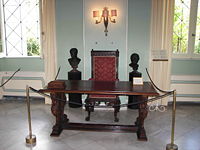
- Brigitte Hamann: The Reluctant Empress: A Biography of Empress Elisabeth of Austria (Knopf: 1986) (ISBN 0-394-53717-3) (410pp.).
- Brigitte Hamann: Sissi, Elisabeth, Empress of Austria (Taschen America: 1997) (ISBN 3-8228-7865-0) (short, illustrated).
- Barry Denenburg: The Royal Diaries Elisabeth, The Princess Bride
- Konstantin Christomanos: Diaries (Tagebuchblätter, several editions in Modern Greek, German, French)
- Matt Pavelich: Our Savage (Shoemaker & Hoard: 2004) (ISBN 1-59376-023-X) (270pp.).
- Nicole Avril: L'impératrice, Paris, 1993
- Matteo Tuveri: Specchi ad angoli obliqui. Diario poetico di Elisabetta d’Austria, Aracne Editrice, Rome, 2006 (ISBN 88-548-0741-9)
- Matteo Tuveri: Tabularium. Considerazioni su Elisabetta d'Austria, Aracne, Rome, 2007 (ISBN 978-88-548-1148-5)
- Matteo Tuveri: Sissi: myth and history, Journal Eco delle Dolomiti, Pinzolo (TN), Italy.
- Matteo Tuveri: Elizabeth of Austria: A Beauvoirian perspective, Simone de Beauvoir Studies, Volume 24, 2007-2008, Published by the Simone de Beauvoir Society (CA - U.S.A.)
|
Elisabeth of Bavaria
Born: 24 December 1837 Died: 10 September 1898 |
||
| Austro-Hungarian royalty | ||
|---|---|---|
| Preceded by Maria Anna of Sardinia |
Empress Consort of Austria 1854 – 1898 |
Vacant
Title next held by
Zita of Bourbon-Parma |
| Queen Consort of Hungary, Bohemia, Croatia, Slavonia and Dalmatia 1854 – 1898 |
||
References
- ↑ Martyrdom of an Empress, (C) 1899 Harpers
- ↑ Biography Base
- ↑ Biography Base
- ↑ Sissi und der Kaiserkuß at the Internet Movie Database
- ↑ "Orchestrator on His Own", Time, 12 December 1932.
External links
- Elisabeth gallery
- Elisabeth website
- [2] Empress Elisabeth
- Elisabeth as film character at the Internet Movie Database
- Sissi: myth and history - by Matteo Tuveri
